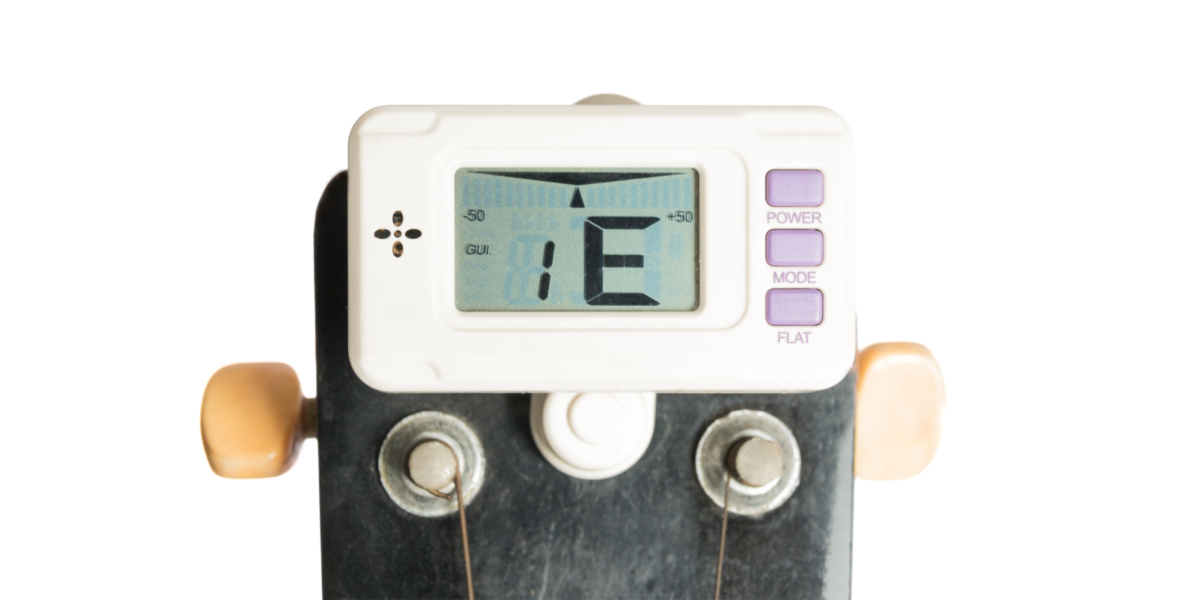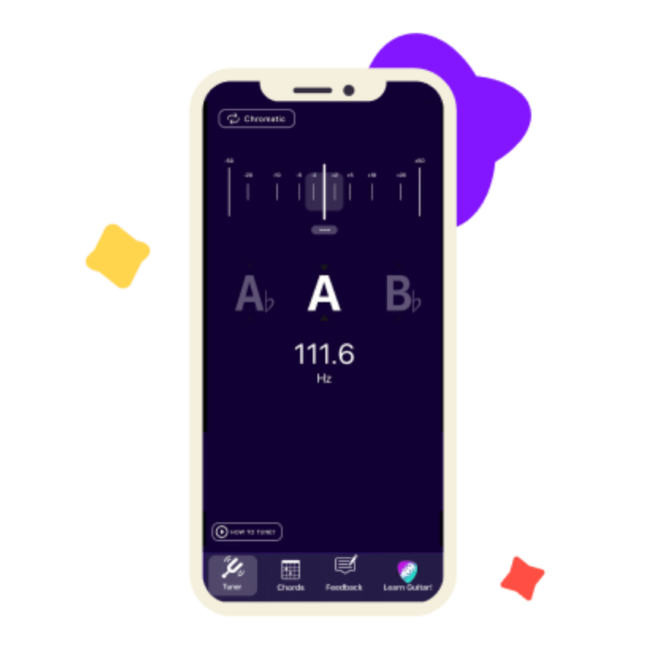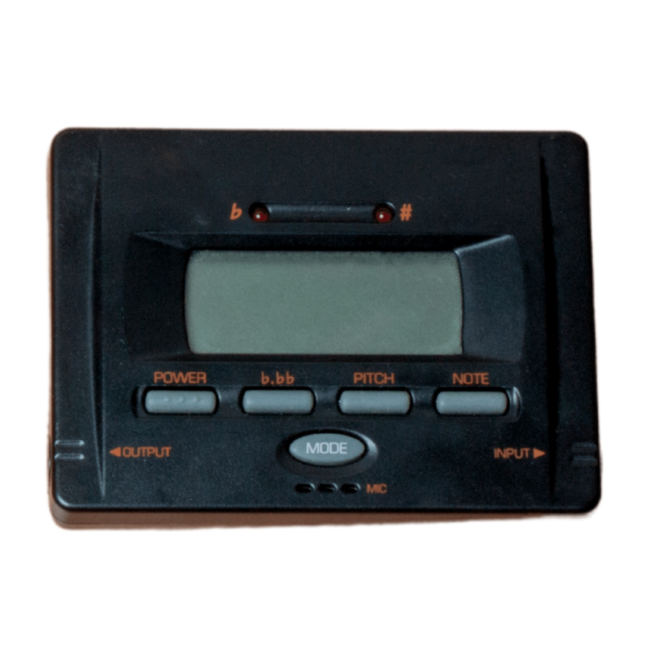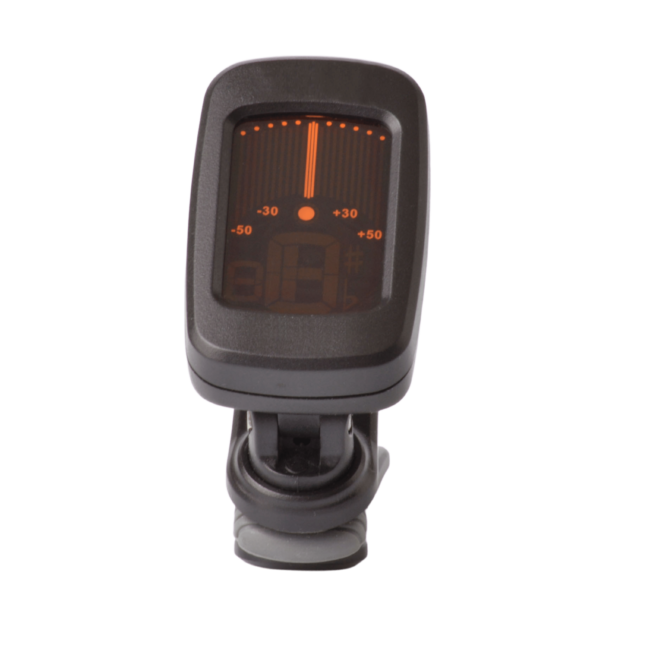How to Use a Guitar Tuner Step-by-Step

Are you new to the world of guitars? Learn how to tune your guitar using a guitar tuner.
A guitar tuner is an essential tool for beginners. It helps keep your instrument sounding how it should. There are tons of tuners on the market.
The truth is, they all work well. It’s just a matter of finding one that you’re comfortable using and that suits your needs and budget.
This blog details everything you need to know about tuners, from the different types, their pros and cons, and how to use them.
What’s a guitar tuner?
A guitar tuner is a device that helps you tune your instrument to the ideal pitch. In other words, they interpret the frequency of a vibrating string.
Frequency refers to the number of times something happens in a given period. A tuner measures the frequency in hertz (Hz). Hertz is the unit of measurement which refers to the frequency of sound in a second.
A guitar tuner picks up the sound of a string via a sensor, cable, or microphone, measures the frequency of the vibration, and compares it to the nearest relative note. The device tells you whether you need to tighten or loosen the tension.
Different types of guitar tuners.
Modern guitar tuners come in all sorts of shapes and sizes. You buy a tuner with various designs, including handheld tuners, clip-on tuners, and pedal tuners. You can even download a guitar tuner app.
Of course, having the right tools makes tuning much easier. However, it may complicate things if you don’t know how to tune your instrument. Learn how by reading our blog, How to Tune a Guitar!
Tuning your guitar.
Before tuning your instrument, there are a few things to keep in mind. There are many tone formats for tuning your guitar. However, as a beginner, you want to set your device to standard tuning.
Generally, a tuner is preset to standard tone (E-A-D-B-G-E). So if you want to change it to an alternative setting like dropped, open, or modal, you have to adjust it.
What does it mean when your guitar is out of tune?
The strings on your guitar are out of tune when they’re too sharp or too flat (tight or loose). This makes the music you play sound funky (not in a good way) and messes with your overall sound, making your vibration feel ‘off.’
How to use a guitar tuner app.
Modern citizens rely heavily on their phones, and it’s no wonder. With it, you can access virtually any bit of information within seconds, send messages through multiple platforms with ease, and download use tools in the form of apps.

You can download a tuner from Apple’s App store or Google’s Play store. There are tons of tuners that work well. A good one to start with is Simply Tune. It works well and is free!
Tuner apps pick up sound waves via a microphone. Most of them offer a built-in guide on how to tune your guitar. Although, that may not be the case for all of them.
Here’s a step-by-step process on how to use a tuner app:
- Download the app of your choice.
- Adjust the tone settings if you need (most tuners automatically tune to ‘standard’ tuning).
- Open the tuning page of your app.
- Play a string and see what the app indicates.
- If your string is out of tune, loosen or tighten it until it is in tune.
- Repeat this process with all of the strings.
Pros:
- Extremely convenient.
- Often free to download and use.
Cons:
- Depending on the hardware (microphone) and environment, they may not work well.
How to use a pedal guitar tuner.
Pedal guitar tuners tune your guitar through electrical signals, identifying them as pitch. They have an input for you to plug your guitar into and an output jack so you can plug your tuner into your amp or another pedal.

Often pedal guitar tuners are ideal for performers. The issue with other tuners that rely on sound is that they also pick up background noise, making tuning your instrument difficult or impossible.
Pedal tuners are the most reliable as they have direct, unhindered access to your guitar’s tone.
To use your pedal tuner:
- Plug your guitar into the device.
- Plug your device into your amp or another pedal.
- Turn on your pedal tuner.
- Play a string. The pedal tuner uses green and red lights to help you tune your guitar.
- Tighten or loosen the string until the light is green.
- Repeat the process with every string.
Pros:
- Pedal tuners offer the most accurate tuning.
- You can tune in any environment, as long as you have a power source.
Cons:
- It can be on the pricier side.
- Have to change the batteries.
How to use a handheld guitar tuner.
Handheld guitar tuners (depending on your device) offer users two methods for tuning. You can tune your guitar using the device’s microphone or plug your guitar (assuming it’s electric) into it.

Handheld tuners are easy to transport, making them the ideal tuning device for any guitarist.
To use your handheld tuner:
- Plug your guitar into your tuner (if you want to tune using electrical signals).
- Turn your tuner on.
- Adjust the settings.
- Play the string you want to tune and observe what the tuner indicates.
- Tighten or loosen the strings.
- Repeat the process for all the strings.
Pros:
- Offers two methods of tuning.
- Ideal for virtually any environment.
- Accurately tunes your instrument.
Cons:
- Need to change batteries.
How to use a clip-on guitar tuner.
Another option is a clip-on guitar tuner. These pocket-sized tuners clip-on to your guitar. The devices are small, easy to store, and typically cost under $20. Most clip-on are chromatic tuners, meaning you can tune your instrument to any note in the chromatic scale.

They work similarly to a tuning app–it picks up sound via a microphone. However, the microphone in a clip-on tuner is specifically designed to tune your instrument. This allows you to tune your guitar with more precision.
To use a clip-on tuner, start by:
- Clipping the tuner on the headstock of your guitar (place it on the tip, so it doesn’t hinder your ability to use the tuning machines).
- Turn on your tuner.
- Pluck a string. The tuner’s screen will indicate whether the string is too flat or sharp.
- Tighten or loosen the string until it’s in tune.
- Repeat the process with each string.
Pros:
- Small and easy to store and transport.
- Tunes accurately.
Cons:
- You have to change the batteries when they die.
- It can damage the finish on your headstock (with years of use).
What guitar tuner is better for beginners?
No type of tuner’s better for beginners than the next. For every kind of tuner, higher and lower-quality devices are available. More sophisticated tuners are more expensive.
When choosing a tuner as a beginner, there is no wrong answer. It ultimately comes down to which type suits your needs. For instance, if you’re playing an acoustic guitar, a pedal tuner doesn’t make sense–you want a tuner that has a microphone.
Consider how much you’re willing to spend, which tuner works best with your instrument type, and the environment you play in the most.
Tuning out
A guitar tuner helps you get your instrument sounding right quickly and accurately. As a beginner, tuning your instrument by ear may not be possible, and playing guitar that’s out of tune is hardly ideal. Therefore, a tuner is essential.
At Simply, we design and create various tools to help you learn practice, tune, and ultimately excel at playing your instrument. Simply Guitar is an app that teaches you everything you need to know about owning and playing the guitar. Take your guitar playing to the next level today!









